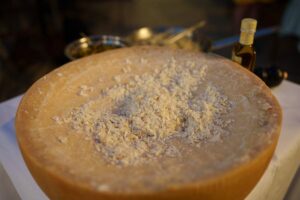Pecorino vs Parmigiano. Both Italian names sound very alike so it is easy to mispronounce them. Additionally, other cheeses can easily be mistaken for the pecorino or parmesan.

Read this article to learn the distinctions between Pecorino and Parmigiano cheese. Particularly about its origins, different types, and methods of production in Italy.
While Pecorino and Parmigiano are both popular Italian cheeses, they are different in several ways.
Pecorino vs Parmigiano, What Is the Difference?
More importantly, can you use one as a substitute for the other?
What is Pecorino?
The Pecorino comes in various types and flavors, with the most famous being Pecorino Romano. The Pecorino Romano is known for its sharp, salty taste.
There are other varieties like Pecorino Toscano and Pecorino Sardo. They have different textures and flavors.
Pecorino cheese is commonly used in Italian cuisine. They are grated over pasta dishes or enjoyed on their own with wine and fruits.
What Is Parmigiano?
Parmigiano is also known as Parmesan cheese. It is a hard, granular cheese from Italy. Although it originates from Italy, it is one of the most famous and widely used cheeses globally.
Parmigiano-Reggiano is typically made from cow’s milk and is known for its sharp, nutty flavor and grainy texture. It’s often grated and used as a topping for various dishes such as pasta, salads, soups, and more.
This cheese is protected by Italian law and can only be produced in specific regions of Italy following traditional methods.
Its Origin
While both cheeses have deep roots in Italian cuisine, they originate from different areas of Italy. Pecorino has a long history dating back to the 12th century.
It was originally made in Italy by Italian monks and now it comes from various regions in Italy. The Pericono Romano having roots in the Roman era, is far older than parmesan.
As the name implies, it was first produced in the “Ager Romanus,” the agricultural region that surrounds Rome. It also has notable varieties like Pecorino Toscano.
Parmigiano-Reggiano, often referred to as Parmesan. These come specifically from the regions of Parma, Reggio Emilia, Modena, and certain parts of Bologna, and Mantua in Italy.
It has a well-documented history that goes back over 900 years.
First Appearance

While Pecorino and Parmesan may appear similar at first appearance, they are very different.
If you put slices of both cheese side by side, you should notice some difference immediately. You’ll notice differences in color texture, and perhaps even a difference in smell.
A slice of Pecorino Romano would be a little, softer and whiter. On the other hand, you’ll notice that Parmigiano-Reggiano, which is made from cow’s milk has a darker, pale yellow colour.
The Type of Milk It Is Made From
The major difference between both cheeses is the kind of milk they are made from. Pecorino is made from sheep’s milk.
This can be deduced from the name as Pecora literally means sheep in Italian. Because it is made from sheep’s milk, it has a tangy, robust flavor.
Parmigiano (Parmesan) is made from cow’s milk and it has a nuttier and milder taste.
Taste or Flavor
Parmigiano-Reggiano tends to have a richer, nuttier flavor with a granular texture due to its aging process. Parmesan cheeses might vary in flavor and texture.
Often, the flavors are less complex and intense. Because sheep’s milk is used to make pecorino romano, it has a more earthy and grassy flavor.
Pecorino cheese has a stronger, spicier flavor than parmesan cheese, which is natural since it’s made from sheep’s milk.
Additionally, Pecorino is usually younger than Parmesan. Pecorino requires only 5-8 months of aging as a minimum. This results in a cheese that tastes greener and is slightly more juicy. Parmesan cheese is fruity and nutty.
Texture and Aging
Both kinds of cheese undergo aging. However, Parmigiano-Reggiano ages longer, anywhere from 18 months to several years, you to three years.
This is what gives it its intense flavor. On the other hand, Pecorino tends to have a shorter aging period. It is aged between several months to a year.
Pecorino comes in three primary varieties in Italy: fresco, semi-stagionato, and stagionato. This classification depends on how long they are aged. Some varieties are aged longer for a more intense taste.
Pecorino tends to be crumbly and firm. Cheeses that are aged longer have a more salty flavor and become crumblier and stiffer, which makes them ideal for grating.
They also age relatively faster compared to Parmigiano, which is hard, granular, and requires longer aging. This is why it has its renowned crystalline texture.
Production Process
How the pecorino and Parmigiano cheeses are produced can vary depending on the regions they come from. Parmigiano-Reggiano follows a strict production process using high-quality cow’s milk.
Whereas Parmesan-style cheeses might have variations in their production methods and may not adhere to the same stringent regulations.
The pecorino undergoes a specific aging so it can have variations such as Pecorino Romano, Toscano, and Sardo.
Which Food Are They Better With?
The Parmigiano cheese is highly versatile. This makes it suitable for grating over pasta, risotto, salads, and as a table cheese or garnish. The best uses for Parmigiano or Parmesan are in recipes, like Chicken Parmesan or Eggplant Parmesan.
They are also used in finishing up meals like Shrimp Fettucine Alfredo and spaghetti with Oil and Garlic (Aglio e Olio).
Pecorino’s bold flavor pairs well with pasta dishes, salads, and soups, adding a distinct sharpness. For instance, the main attraction of the dish cacio e pepe is usually pecorino romano.
With the acidic nature of the cheese, the dish really showcases the tangy flavor. Pecorino is also a great grating cheese. It tastes great on salads and spaghetti.
Don’t forget that there are also other types of Pecorino you could try aside from the Romano. The Pecorino Siciliano for instance is something prepared with black peppercorns.
Can You Use Them Interchangeably?

Both of these cheeses have their unique tastes and textures. The answer to the question of whether you can use them interchangeably is both yes and no.
In many recipes, Parmigiano-Reggiano and Parmesan cheese can be used interchangeably. You can substitute one for the other especially when you’re grating it to be used as a topping or ingredient.
These are in dishes like pasta, salads, soups, or sauces. However, in recipes that require either one specifically, keep in mind that there might be slight differences in flavor.
Parmigiano-Reggiano has a nuttier and more intense flavour. This would add a deeper taste to your dish compared to the Parmesan cheese.
Therefore, it is recommended that where a recipe specifically calls for one or the other, use the recommended cheese. This way you can achieve the intended taste.
While you can substitute Parmesan for Pecorino in an emergency food situation, it’s best to use the cheese that the recipe specifies.
Additionally, when replacing Parmesan with Pecorino, keep in mind that the latter tends to taste saltier. In such a case, use about one-third less Pecorino.
For dishes where the cheese is the star of the dish, you should use the recommended cheese. if you’re aiming for an authentic Italian taste, using Parmigiano-Reggiano might be preferable.
Although to be honest, in most everyday cooking, we use them interchangeably without paying attention to the differences.
But next time you need to cook something that requires the Pecorino or Parmigiano/ Parmesan, you can spot the difference.
